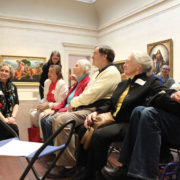WASHINGTON — For today, there are no doctor’s visits. No long afternoons with nothing to do. No struggles over bathing — or not.
At the National Gallery of Art in Washington, D.C., a group of older adults — some in wheelchairs, some with Alzheimer’s — and their caregivers sit in a semicircle around a haunting portrait of a woman in white.
“Take a deep breath,” said Lorena Bradford, head of accessible programs at the National Gallery, standing before “The Repentant Magdalen” by Georges de La Tour.
“Now, let your eyes wander all over the painting. Take it all in. What do you think is going on?”
“I think she looks sad,” said Marie Fanning, 75, of Alexandria, Va., an Alzheimer’s patient.
“Yes. Yes, she looks sad,” said Bradford.
“This is such a gift,” Bill Fanning, 77, Marie’s husband and caregiver, said of the outing.
Across the country, community groups, hospitals, government agencies and nonprofits are doing more to support at least some of the estimated 42 million people who are the primary caregivers of adults and children who have disabilities, are recovering from surgeries and illnesses or are coping with Alzheimer’s and other chronic diseases.
In California, for instance, Dignity Health Systems, the state’s largest nonprofit hospital company, is partnering with the nonprofit Santa Barbara Foundation to provide caregiver coaches to help caregivers transition their patients to home care. At any given time, 1,000 caregivers are being coached, said Kathleen Sullivan, vice president of acute care services for Dignity.
“Now caregivers are identified as a partner in the health team” of the patient, she said. “They’re given a badge, they have a tote bag with information, and the hospital knows who to contact.”
The group works with nonprofit aging agencies to provide in-home coaches, she said. “When people get home from the hospital, they’re just exhausted. They don’t remember what they were told in the hospital.”
The National Gallery’s program in Washington, D.C., focuses on the health, well-being and education of caregivers, as well as those they are caring for.
“We know that involvement with art improves well-being. In our own research for persons with dementia, we see a reduction in apathy. For caregivers, we see less isolation and a reduction in stress,” said Carolyn Halpin-Healy, executive director of the Arts & Minds program for caregivers and patients at the Metropolitan Museum of Art in New York.
She co-founded the program with Columbia University neurologist James Noble in 2010 at the Harlem Studio Museum in New York. The Just Us program in Washington is a spinoff of that program. Other museums in New York and Dubuque, Iowa, have similar programs.
A new bipartisan law signed by President Donald Trump in January calls for a national strategy to address the needs of caregivers, who are primarily women and provide 37 billion hours in unpaid care to relatives or close friends valued at $470 billion, according to an AARP study. The law will require the Department of Health and Human Services to set up an advisory council and develop a blueprint for government action on financial, workplace, respite care and other caregiver issues.
At the same time, 42 states — including California — have passed laws requiring hospitals and other facilities to provide training for caregivers who perform medical tasks, and to record them as the “caregiver” when patients are admitted or released from hospitals or nursing facilities. In states without that law Alabama, Florida, Georgia, Idaho, South Carolina, South Dakota, Vermont and Wisconsin (Kansas’ law takes effect in July) — patients can be dismissed from the hospital without family members being told or briefed fully on what care the patient needs.
The CARE Act is “more than just a law,” said Elaine Ryan, AARP vice president of state advocacy and strategy. “It’s a change in the practice of health care.”
Helping the helpers
Caregivers are almost two times more likely to have emotional and physical problems, and three times more likely to have productivity problems at work, according to a 2015 study by Johns Hopkins. The more intense the care, the greater the effects, the study said.
Dr. Eric Coleman, a gerontologist who received a MacArthur “genius award” grant in 2012, created the Care Transitions Intervention model (CTI). The national program based at the University of Colorado in Denver trains coaches. The coaches are usually social workers, nurses or others hired by hospitals and other facilities to work directly with caregivers.
Coaches talk to the caregiver before patients are discharged from a hospital. Then they have a one-hour coaching session at the patient’s home, and three follow-up phone calls. Studies have shown that having transition coaches can drop readmission to hospitals by 20 to 50 percent, said Coleman.
Even if a caregiver is with the patient when doctors give instructions, the medical talk can go right over their heads, he said. “We tell people that for the next 24 to 48 hours, here are key things you need to do. Then we follow up at home,” he said.
Caregivers do more than make meals; they perform medical tasks like giving medicine, taking blood pressure, changing bandages and more. Yet they receive virtually no training, Coleman said.
“I’m a physician, and when I take care of my mom, I have an endless loop in my head,” of the to-do list, he said.
A study by AARP found that 46 percent of family caregivers perform medical/nursing tasks, 78 percent of family caregivers manage medications, and 53 percent of family caregivers serve as care coordinators. The majority said they received no training.
Caregivers are “the backbone of our health system,” said Dr. Alan Stevens, a gerontologist who trains caregivers in partnership with Baylor Scott White, the largest nonprofit hospital company in Texas, and a group of aging agencies across the state.
“If caregivers go away, we have a problem. It’s important to better understand their needs — and to help them.”
Linking hospitals with caregivers
In Virginia, the Bay Area Council on Aging and a consortium of four other groups and five hospitals are training caregiver coaches using the CTI program. The key to successful coaching of caregivers is to take training to the homes of caregivers and patients, said Kathy Vesley, of the Bay Area Council on Aging in Fredericksburg, Va.
“Some of these folks are very ill and they’re managing 12-plus medications,” said Vesley. “You get into the home and they say, ‘Here’s my shopping bag of medicines.’ And it’s literally a shopping bag.”
The consortium has seen 26,000 patients and caregivers over the past 2½ years and readmission to the hospitals fell from 23.4 to 9 percent, she said. Coaches help with food, medicine and video training for how to do medical procedures and help solve issues like how to get patients to doctor’s appointments.
Out in rural southeastern Virginia, “transportation takes a whole new meaning,” she said, “when your driveway is half a mile long.”
Having fun helps, too
Caregivers need a little fun and relaxation, said Jason Resendez, executive director of the Latinos Against Alzheimer’s Coalition. About 8 million Latinos are caregivers for their family members, and nearly 2 million are caring for family members with Alzheimer’s, he said.
For instance, in Los Angeles, Latino groups partnered on a play performed in Spanish about a son who is his mother’s caregiver. It was a comedy. And in Chicago, the Latino Alzheimer’s and Memory Disorders Alliance (LAMDA) holds caregiver training — and free salsa dancing classes.
“It’s not just about translation; it’s not just about handing out pamphlets,” he said.
This story was produced by Kaiser Health News, an editorially independent program of the Kaiser Family Foundation. (Mindy Fetterman/Kaiser Health News)





